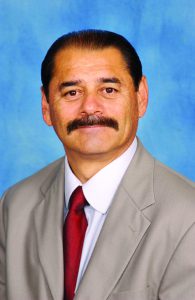Family and National City: These are the two most important pillars in the life of Robert ‘Dukie’ Valderrama, National City’s appointed Port Commissioner.
Vallderrama is one of seven commissioners who govern the Port of San Diego, the local agency responsible for the development of port lands along the bay in San Diego, Imperial Beach, Coronado, Chula Vista, and National City. He was appointed as National City’s Port Commissioner in January 2005.
Although he has had plenty of success in the private and public sector, Valrerrama says nothing compares to family.
“I grew up in National City. We were poor, but you can’t buy family time,” says Valderrama, now 67 years old. “Now, when the whole family gets together, it adds up to about 200 people. We wear different colored shirts to identify all the generations,” he adds.
As it turns out, that strong sense of family actually influenced Valderrama’s business style. Before being appointed to represent National City on the Board of Port Commissioners, he was the owner of a drywall and scaffolding company. When speaking to CEOs from other businesses, he recalls one owner telling him: “I would never lend money to an employee.” This intrigued Valderrama, because in the past, he had done just that.
“It is a matter of listening and trusting,” recalls Valderrama. “I had employees ask me for money. Instead of flat out saying ‘no’ I would ask them what the money was for. Sometimes they’d say: ‘My mother passed away. I need cash to have her buried in Mexico.’ How do you say no to that? Once you lend them the money, it builds trust and loyalty in a business. Because I made a commitment to them, they make commitment to me. It’s like family.”
Valderrama graduated from Sweetwater High School and married his high school sweetheart 46 years ago. Back then, he was not exactly sure what he wanted to focus on, but he knew he wanted to give back to the community.
Over the years he worked with the County of San Diego, served on the Southwestern College Foundation Board, and the South County Economic Development Committee. The lengthy list goes on, but now, as a Commissioner for the Port, his focus is making the area more attractive for locals and tourists alike. Even more than that, he says his main responsibility is to make sure National City gets the same benefits as from the port as the other bay cities.
“The bay port lands are owned by the State of California,” explains Valderrama. “So there are limits. I can’t just go in and make decisions that relate to National City. We’re in charge of Seaport Village, Harbor Island, and hotels that are by the sea front. We have to make decisions to improve the entire area.”
But one specific improvement is indeed geared towards the South Bay. Redevelopment of the Chula Vista Bayfront Master Plan covers about 550 acres. Over 50 percent will be open land, with the other portion to include hotels, shops, and a type of convention center.
“Right now, students from the South Bay have to go to San Diego to celebrate their proms,” says Valderrama. “There’s not a big enough venue that can accommodate so many people in Chula Vista or even National City. That is going to change.”
Looking back at his career in public service, Valderrama says one thing is crystal clear: More Hispanics are getting involved in the process and being vocal about it. When Valderrama was starting out, he says he was the only Hispanic in most meetings. Seeing Latinos speak out in city meetings was rare.
“Power comes from having the right people in the right positions,” explains Valderrama. “When I go out and see all the younger Hispanics coming up, it makes me feel good. As an elder in the Chicano movement, we are seeing people move up. We broke down the barriers,” Valderrama adds.
Times have changed quite a bit. When Valderrama was growing up, his parents made it a point for him and his siblings to speak only English at home. His father, who was born in Mexico, had been teased as a child for not speaking English well enough. His parents did not want him to go through the same.
“We would speak a few words in Spanish here and there with our grandparents,” says Valderrama. “But my parents made sure we were very fluent in English. Spanish really was not spoken that often. One of the sad parts of growing up is that we were not as bilingual as we probably should have been.”
National City is often seen as the low income area of the County. When Valderrama is asked why, despite all his success, he still chooses to live there, the answer, he says, is simple: “My family is here and this is where I’m from. Why would I move? I could move to another community, but it’s not who I am,” he concludes.
